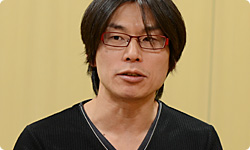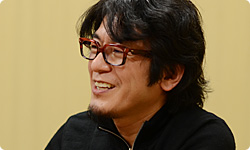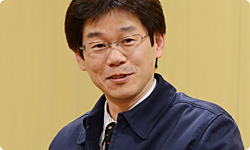Yokota-san, you’ve been in charge of all sorts of games. What was characteristic of the development process this time?
Maeda-san’s toughness, his continual adoption of ideas and the way he thinks about things incredibly positively really stood out this time. I’ve never seen him look tired. That’s the most amazing thing.
Even though he looked on death’s door when planning the new project.
(laughs)
Was it more tiring to think about Fire Emblem on Mars?
Uh-huh! I was confused! (laughs)
But piling up new things in a positive way resulted in a new style of play. For example, you can develop the characters endlessly, so even if a character’s stats don’t increase much when you level up, you can continue without worrying because you’ll have plenty of chances later on. What’s more, in Newcomer Mode6, even if a comrade is defeated, you can still continue to develop them.6. Newcomer Mode: A mode where if a comrade character becomes incapacitated, that character isn’t lost and will be available for use on later maps. This mode first appeared in the previous game, Fire Emblem: Shin Monsho no Nazo.
Is there still controversy over Newcomer Mode?
No, it’s all right now.
I’d like to hear what you really think.
No, no! It’s really all right! (laughs) A lot of people at the company even play casually.
Some people think Newcomer Mode is heresy, while no doubt some would say they only discovered the enjoyment of Fire Emblem because of it.
Yes, there are quite a few of the latter. Especially among team members who played it for the first time – some said it was difficult without casual play, so I thought Yamagami-san had shown foresight. Sorry for getting huffy about that on the phone. (laughs)
No, no. But that was a surprise. It really was!
(laughs loudly)
I was totally against it from the start, too. But after coming to work on it, I thought Newcomer Mode was great! (laughs)
There are different ways to play and enjoy it – for instance, seriously or carefree.
That’s right. There are two modes and three difficulty settings, so it was difficult to get the balance. (laughs) If you combine Normal with Newcomer Mode, it could be a little easy.
But when we had new employees test play it, I realised there was a value to having various modes, because if it was too difficult on Classic Mode, they could play to the end in Newcomer Mode. Because of this, I think a lot of people will play all the way to the end.
And we can’t go without mentioning how Higuchi-san and Maeda-san applied themselves to adjusting the difficulty so their wives could play it. (laughs)
No, no…let’s leave that out! (laughs) The three difficulty levels are Normal, Hard and Lunatic7, and they each play a certain role. Normal is recommended for people who regularly play RPGs, and we can recommend it to beginners. On the other hand, we want true masters of Fire Emblem to play on the Lunatic setting!7. Lunatic: The highest difficulty setting in Fire Emblem. This mode first appeared in Fire Emblem: Shin Monsho no Nazo. Enemy capabilities are higher across the board and all enemy weapons are advanced-class.

It’s a challenge from the developers.
Maeda-san cleared it!
Yes. I did clear it on Lunatic… and the difficulty was incredible!
(laughs wryly)
Narihiro-san seems perplexed.
Lunatic is beyond me.
Narihiro-san says it’s impossible. (laughs)
There are hidden elements above that, too.
The challenge from the developers is the ultimate test.
When it comes to the roles they each play, I think Hard is just about right, but – no, Hard is pretty tough stuff. But Lunatic just isn’t right!
Like the difference between very serious and simply masochistic? (laughs)
Yes! (laughs) This time, I think people who play it once on Normal will then want to play it on Hard.
Ah. If that’s true, then you’ve polished up the difficulty perfectly.
Yes. It’s balanced just right. I was keeping an eye on the progress this time from a stance similar to that of the general player, but after I finished playing it comfortably in Normal, I wanted a little more and felt like taking it on in Hard, which is something I thought might have been missing from recent Fire Emblem games.
I don’t know if it’s what they were really aiming for this time, but in the end, I thought it was made with a great amount of variety. So while it’s pitched in terms of difficulty settings, I think players will be able to enjoy various slightly different kinds of gameplay.

I feel like that can’t be described simply as ‘difficulty’.
Right. But I’m praising it, you know. (laughs)
Yes. (laughs)
As mentioned earlier, development took a long time from the initial conception, but if we had been shooting for an amalgamation from the start, I don’t think it would have turned out this way. In the end, it turned out as an amalgamation precisely because we overcame that period of difficulty.
That’s right. Starting by trying to change it – even going so far as to consider Mars and 2011 versions – led to this amalgamation. Some kind of essence from those discussions over expanding and changing it is surely included in this amalgamation.
Yes. I think that dark time we passed through led to good results.
What Narihiro-san just said is suggestive of the title. The subtitles in Japanese and the logo have always adopted a certain form. Changing that for a traditional series takes some courage. Who opened the way for that?
With the title, IS and I wanted to change it and put forth various ideas, but nothing seemed to fit. So we came up with one following the usual convention and showed it to Yamagami-san, but he said it wasn’t right.
From the same kind of title, you couldn’t sense your determination to change the game.
Right. Then I just tossed out, “We need something that hits with impact! Like ‘Awakening’! And he was like, “Oh, that might work…” (laughs)

That word really struck home. At that stage, no ideas came up that could beat it, so in one shot we decided to call it Fire Emblem: Awakening.
As for changing the logo, we would be putting the name “Awakening” in it, so it just followed from wanting a logo that would fit that.
We all agreed that we wanted the overall design to be more stylish, so we decided on it relatively quickly.
Were you nervous when you released it to the fans?
Yes, but instead of having them think it was the same old same old, I wanted to make an impact, so I wanted to know as soon as possible what everyone’s impression was. I thought it would be better that it was talked about in as many places as possible.
The word ‘Awakening’ synced up perfectly with your determination to make the ultimate amalgamation of Fire Emblem.
I suppose so. We should talk about the game mechanics we put in by unanimous consent so as to definitely not depart from that ultimate amalgamation. But Yamagami-san should talk about that…
© 2024 Nintendo.